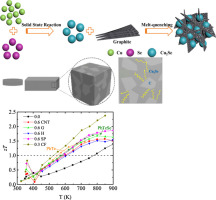当前位置:
X-MOL 学术
›
Nano Energy
›
论文详情
Our official English website, www.x-mol.net, welcomes your
feedback! (Note: you will need to create a separate account there.)
Significant enhancement of figure-of-merit in carbon-reinforced Cu2Se nanocrystalline solids
Nano Energy ( IF 16.8 ) Pub Date : 2017-09-09 , DOI: 10.1016/j.nanoen.2017.09.020 Lanling Zhao , Sheik Md Kazi Nazrul Islam , Jun Wang , David.L. Cortie , Xungai Wang , Zhenxiang Cheng , Jiyang Wang , Ning Ye , Shixue Dou , Xun Shi , Lidong Chen , G. Jeffrey Snyder , Xiaolin Wang
Nano Energy ( IF 16.8 ) Pub Date : 2017-09-09 , DOI: 10.1016/j.nanoen.2017.09.020 Lanling Zhao , Sheik Md Kazi Nazrul Islam , Jun Wang , David.L. Cortie , Xungai Wang , Zhenxiang Cheng , Jiyang Wang , Ning Ye , Shixue Dou , Xun Shi , Lidong Chen , G. Jeffrey Snyder , Xiaolin Wang

|
Liquid-like ionic conductors in the copper selenide family represent a promising class of thermoelectric materials capable of recycling waste heat into electrical energy with an exemplary figure-of-merit (zT > 1.4) above 800 K. Ion diffusion, however, is enhanced at such high temperatures and drives a non-reversible phase segregation that inhibits practical applications. In tandem, the thermoelectric performance at moderate temperatures (500 − 750 K) where ion diffusion is less problematic, is not optimal for real-world applications (zT < 1). In this work, we demonstrate that incorporating a small weight fraction of carbon using various carbon sources can significantly enhance the zT of Cu2Se at both middle and high temperatures. All the carbon-doped Cu2Se samples exhibit weak temperature dependent zT higher than 1.0 over a broad temperature range from 600 to 900 K, with the 0.6 wt% Super P doped Cu2Se sample achieving a zT of 1.85 at 900 K. Furthermore, the 0.3 wt% carbon fiber doped Cu2Se shows zT > 1 for T > 520 K and reaches a record level of zT of ~ 2.4 at 850 K. These values for the carbon doped Cu2Se are comparable or superior to those for the current state-of-the-art thermoelectric materials. Microstructure studies on graphite incorporated Cu2Se revealed that graphite nanostructures interspace between Cu2Se nanoscale grains being responsible for the significantly enhanced zT. The low thermal conductivity in the nanostructured composite is attributed to the high density of interfaces caused by the small grain diameters (30 − 60 nm), along with the strong acoustic mismatch between Cu2Se and carbon phonon states which enhances the thermal boundary resistance. This discovery indicates strong prospects for engineering carbon thermoelectric nanocomposites for a range of energy applications.
中文翻译:

碳增强的Cu 2 Se纳米晶固体的品质因数显着提高
硒化铜家族中的液体状离子导体代表了一种有前途的热电材料,能够将废热回收为电能,其典型的品质因数(zT > 1.4)高于800K。如此高的温度并导致不可逆的相分离,从而阻碍了实际应用。同时,离子扩散问题较少的中等温度(500-750 K)的热电性能并不是现实应用的最佳选择(zT <1)。在这项工作中,我们证明了使用各种碳源掺入少量碳可以显着提高Cu 2的zT硒在中温和高温下均如此。所有的碳掺杂Cu 2 Se样品在600至900 K的宽温度范围内均表现出弱于温度的zT值,高于1.0,而0.6 wt%的Super P掺杂Cu 2 Se样品在900 K时的zT为1.85。中,0.3 重量%的碳纤维的掺杂的Cu 2硒节目的zT > 1 Ť > 520 K和到达的记录电平的zT〜2.4的在850 K.这些值用于该碳掺杂的Cu 2Se与当前最先进的热电材料相当或更好。对掺入Cu 2 Se的石墨的微观结构研究表明,Cu 2 Se纳米级晶粒之间的石墨纳米结构的间隙是显着增强zT的原因。纳米结构复合材料的低导热性归因于小粒径(30-60 nm)引起的界面高密度,以及Cu 2 Se和碳声子态之间的强烈声失配,从而增强了热边界电阻。这一发现表明,工程碳热电纳米复合材料在一系列能源应用中具有广阔的前景。
更新日期:2017-09-10
中文翻译:

碳增强的Cu 2 Se纳米晶固体的品质因数显着提高
硒化铜家族中的液体状离子导体代表了一种有前途的热电材料,能够将废热回收为电能,其典型的品质因数(zT > 1.4)高于800K。如此高的温度并导致不可逆的相分离,从而阻碍了实际应用。同时,离子扩散问题较少的中等温度(500-750 K)的热电性能并不是现实应用的最佳选择(zT <1)。在这项工作中,我们证明了使用各种碳源掺入少量碳可以显着提高Cu 2的zT硒在中温和高温下均如此。所有的碳掺杂Cu 2 Se样品在600至900 K的宽温度范围内均表现出弱于温度的zT值,高于1.0,而0.6 wt%的Super P掺杂Cu 2 Se样品在900 K时的zT为1.85。中,0.3 重量%的碳纤维的掺杂的Cu 2硒节目的zT > 1 Ť > 520 K和到达的记录电平的zT〜2.4的在850 K.这些值用于该碳掺杂的Cu 2Se与当前最先进的热电材料相当或更好。对掺入Cu 2 Se的石墨的微观结构研究表明,Cu 2 Se纳米级晶粒之间的石墨纳米结构的间隙是显着增强zT的原因。纳米结构复合材料的低导热性归因于小粒径(30-60 nm)引起的界面高密度,以及Cu 2 Se和碳声子态之间的强烈声失配,从而增强了热边界电阻。这一发现表明,工程碳热电纳米复合材料在一系列能源应用中具有广阔的前景。











































 京公网安备 11010802027423号
京公网安备 11010802027423号